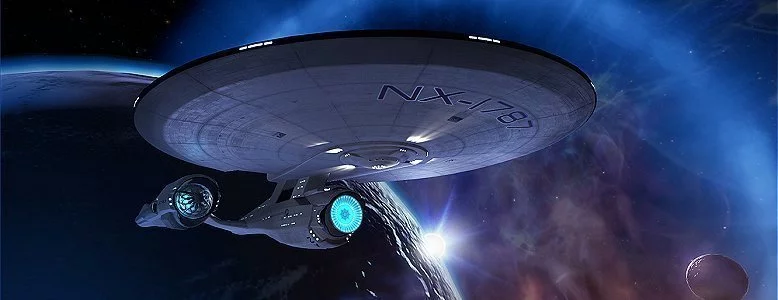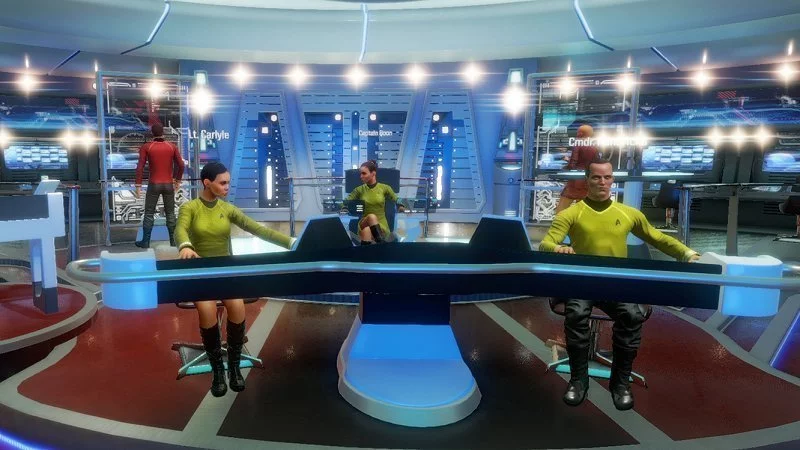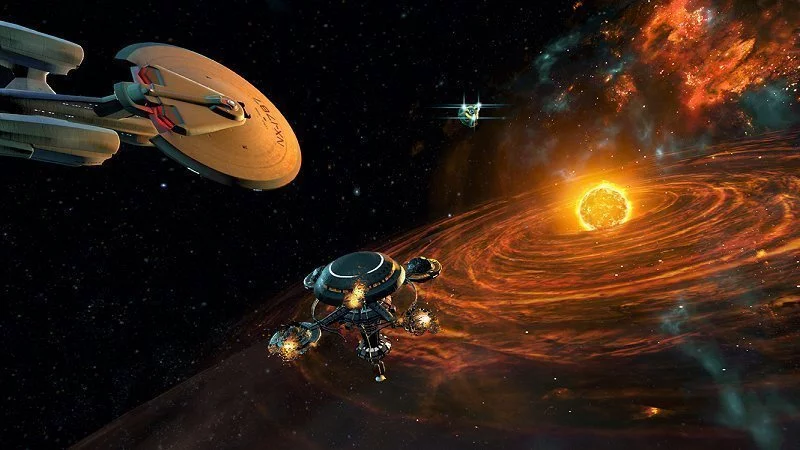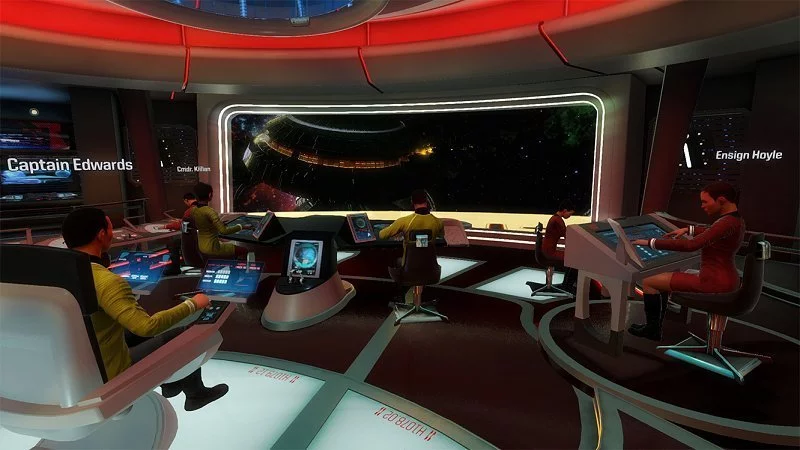When it comes to sci-fi franchise virtual reality (VR) offerings at Gamescom, I can wholeheartedly assert that Star Trek: Bridge Crew easily kicked Star Wars: Battlefront: Rogue One X-Wing VR Mission’s ass.
Not just because of the games’ names, either.
While I enjoyed Star Wars VR, it took a familiar experience and added a bit of flash to it. I’m used to playing a game from inside an X-Wing cockpit; I literally grew up with Star Wars: X-Wing. I loved pulling out the ol’ joystick, connecting it to my shonky 386 and taking a spin around the galaxy. Star Wars VR is exciting because that same experience can now be beamed straight into my brain in glorious HD.
In short, I’m not knocking it.
But Star Trek: Bridge Crew? It’s another story altogether.
I’ve loved Star Trek for as long as I can remember. I might have spent my youth blowing up pixelated Tie Fighters, but I yearned for a chance to be on the bridge of Kirk’s Enterprise. With Star Trek: The Next Generation, my love became an obsession. Back in 1990, I was certain Jean-Luc Picard – who clearly wasn’t just a fictional character – would slingshot around the sun, travelling back in time, for the express purpose of finding and beaming me aboard.
I would replace Wesley. That punk.
While Star Wars fans have always had the chance to live out similar fantasies via video games, the closest I’ve ever gotten was Star Trek: A Final Unity and Star Trek: Elite Force, the only two decent games the franchise has ever received. The former was a point and click adventure and the latter, while billed as a shooter, excelled because it gave me the chance to explore (a completely empty) U.S.S. Voyager, deck by deck, as a bonus feature.
Unlike Elite Force — which was devoid of any other characters in its most immersive mode — Star Trek: Bridge Crew places four players at key points on a bustling Starfleet bridge. As either the Captain, the helmsmen, a tactical officer or engineer, the four crewmembers are tasked to work together to explore, aid and fight. Set in the new Kelvin-timeline (that’s the Chris Pine and Zachary Quinto movie universe), you’re not on the Enterprise, but the U.S.S. Aegis — an experimental, deep-space exploration vessel.
“We’re not focused on the Enterprise,” Justin Achilli, Lead Game Designer, told Stevivor. “We’re not focused on Kirk. We’re not focused on Spock. We’re focused on you and your ship — these are your voyages.
“What decisions do you make as Captain? How do you guys gel as a crew? Bridge Crew is intended to put you on the deck of a Starfleet vessel, the way you haven’t been able to before without VR.”
Even before you get to the Aegis’ bridge, Ubisoft’s Red Storm shows it can be just as flashy as Battlefront. Where the latter gives you a clean, sterile environment to inspect your X-Wing, my Bridge Crew experience opened with a glorious shuttlecraft fly-by of the Aegis. It’s (almost quite literally) a Star Trek fan’s wet dream.
While the shuttlecraft mightn’t be available at all times in the full game, Achilli did confirm the Aegis’ Briefing Room will be a central part of the game — a pre-mission lobby that doubles as a visual feast for the eyes.
It was the same in the shuttle. From it, I was able to move around to really detect the design differences that separated the Aegis from the Enterprise. Its form factor is squashed, with a shorter neck between the engineering and secondary hulls. Its nacelles? Huge. Almost over-the-top huge.
Two minutes into gameplay, and I’d already decided the Aegis – still with an experimental, NX registry — was a thing of beauty. Even before I’d set foot inside it.
“The Aegis is intended to explore,” Achilli said. “It’s intended to scout. The gameplay itself will focus a lot on those activities.”
Current reports suggest the core of Bridge Crew’s campaign will focus on the Aegis crew finding a suitable planet for a number of Vulcan refugees to settle upon. While Achilli wouldn’t get into any more detail, he said that was very much on the right track.
The Aegis’ bridge is straight out of the new Star Trek films – thankfully, with none of the J.J. Abrams lens flare. It’s not a carbon copy though; the bridge I stood upon was clearly far wider than the one seen on the Enterprise. At least, that’s what I think — it’s since occurred to me that it simply might have felt bigger because I was actually inside of it, in a way that a TV show or movie will never be able to replicate.
The Gamescom mission I played had me warping to a nearby system and transporting stranded survivors aboard the ship before their life support ran out. Simple, right? Well, maybe.
Sitting at the helm – ‘cause I was determined to live up to Sulu’s reputation as a maverick, gay pilot – I was briefed on my station. For the Gamescom build, I was able to operate forward or reverse thrusters, control speed, steer the ship and go to warp. I could also use limited sensors to track objects in order to move to them with more efficiency. The actions were performed using the Oculus Rift handheld Touch controllers. Strapped to each hand, I moved either as needed and hit a button to activate a panel or grab a dial.
“This was just a kind of show demo,” Achilli later told me. “The controls at the stations are a little bit simpler.
“For the long-term play, there will be different activities for the different stations to do. The more skilled you get with a station, the more there will be to continuously challenge you. And, of course, the missions will become more difficult as they progress.”
You’ll also be able to customise your character in the full game; although this wasn’t a feature demonstrated at Gamescom.
“There is customisation involved – you’ll be able to customise faces, so a player can look across the bridge and recognise you,” Achilli said. “Of course, you’ll be able to play as a male or female, and for now, we’ve confirmed you can play as a human or a Vulcan.”
Achilli’s intonation suggested more races would be on the way.
As my engineer primed the Aegis’ core, I lined up for a warp jump, manoeuvring the ship so that a series of orange pre-warp gates turned blue. With my (virtual) hand on the chromed throttle, I informed our Captain – a Red Storm dev – that we were ready to go to warp.
“When you’re ready,” he replied.
I broke rank — and character — at that point.
Turning around to face the dev Captain – and trying to ignore just how cool it was to look from the helm and the viewscreen in a 180 degree arc around the bridge – I screwed up my face in a bit of disgust.
“But,” I whimpered; actually whimpered. “Can you please ask me to ‘punch it’ instead?”
I remembered my place almost immediately.
“Um… sir?”
Thankfully, my Captain laughed — and waved at me for effect. I waved back.
“Of course,” he exclaimed. “Punch it!”
I swung my head back around, found the throttle and gave it everything the Aegis had. My mouth dropped open in delight as I – me, a Star Trek fanboy – brought a Starfleet ship to warp. Stars transformed from small specks to brilliant streaks of light ahead of me on the viewscreen.
I’ll admit it: I squealed a bit… and hummed the hook of Michael Giacchino’s main theme until we reached our destination. While some might liken this loop – really, the core of Bridge Crew’s gameplay – to a button-pushing simulator, I was clearly in my element.
From there, sh*t hit the fan. I expertly navigated to three distinct lifeboats the Aegis had been tracking, but the journalists at Engineering and Tactical – who admitted they weren’t really familiar with Star Trek – had trouble locking on to lifeforms and engaging transporters. They proved equally useless when Klingons dropped out of warp, weapons hot. Without scoring a single shot back in retaliation, I was forced to stop tracking the Warbirds and instead made an emergency warp out of the system. We’d only managed to save those on two of the three lifeboats.
Just before we warped back, my Captain commanded me to hit the X button on my left-hand Touch controller. That swapped into Space View, a feature that takes you outside the bridge to an external camera set on the Aegis’ saucer section. I was treated to a view of the nebula we were circumventing, framed only by a bit of the Aegis’ hull itself.
I also snuck into the view while we were at warp and almost lost my mind. It was beautiful, far more picturesque than anything I experienced in Star Wars VR.
Back at Starbase, we officially termed the mission a moderate success. It ran about 20 minutes long, mirroring what players should expect in the finished product.
“The VR experience we’re aiming for in each mission is probably about a 15- to 20-minute experience,” Achilli said. “So you can play multiples in a row.
“We also have, in addition to the campaign mode, a mission generator. You can say, ‘we want to play a mission; I don’t care what it’s attached to,’ and just go.”
From what I experienced in a small room in Gamescom that doubled as the Aegis bridge, I’d be very happy to just go — and boldly, at that. It’s everything young Trekkie Stephen has ever wanted, and more than enough reason to take the plunge and actually invest in an at-home VR solution.
Star Trek: Bridge Crew heads to PlayStation VR, Oculus Rift and HTC Vive on 29 November.
This article may contain affiliate links, meaning we could earn a small commission if you click-through and make a purchase. Stevivor is an independent outlet and our journalism is in no way influenced by any advertiser or commercial initiative.



























